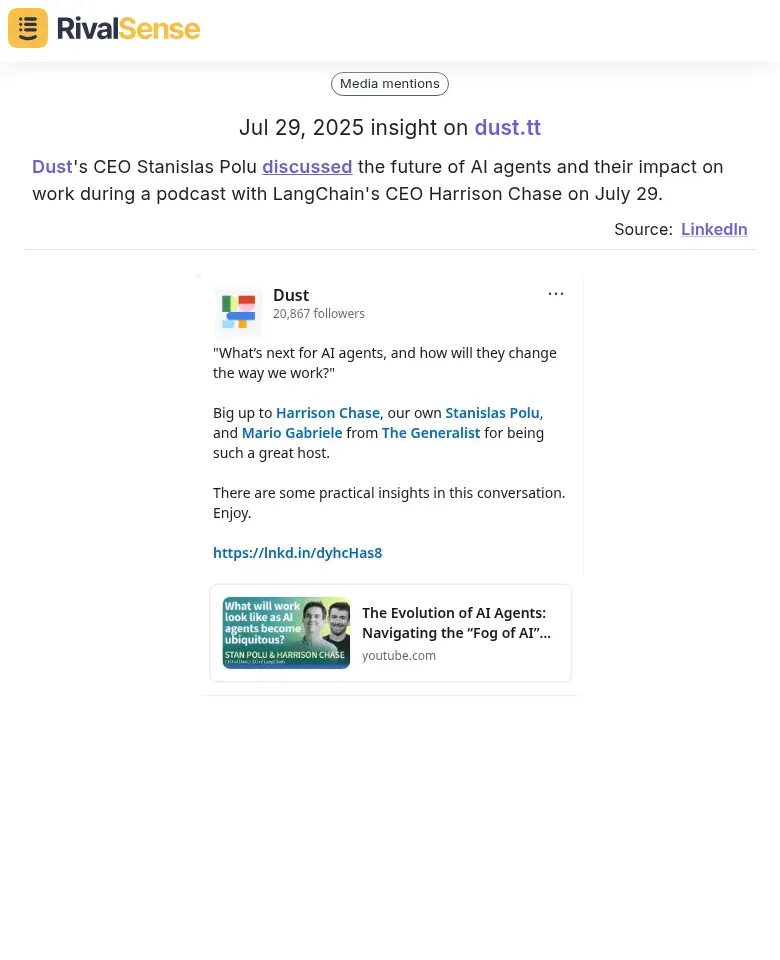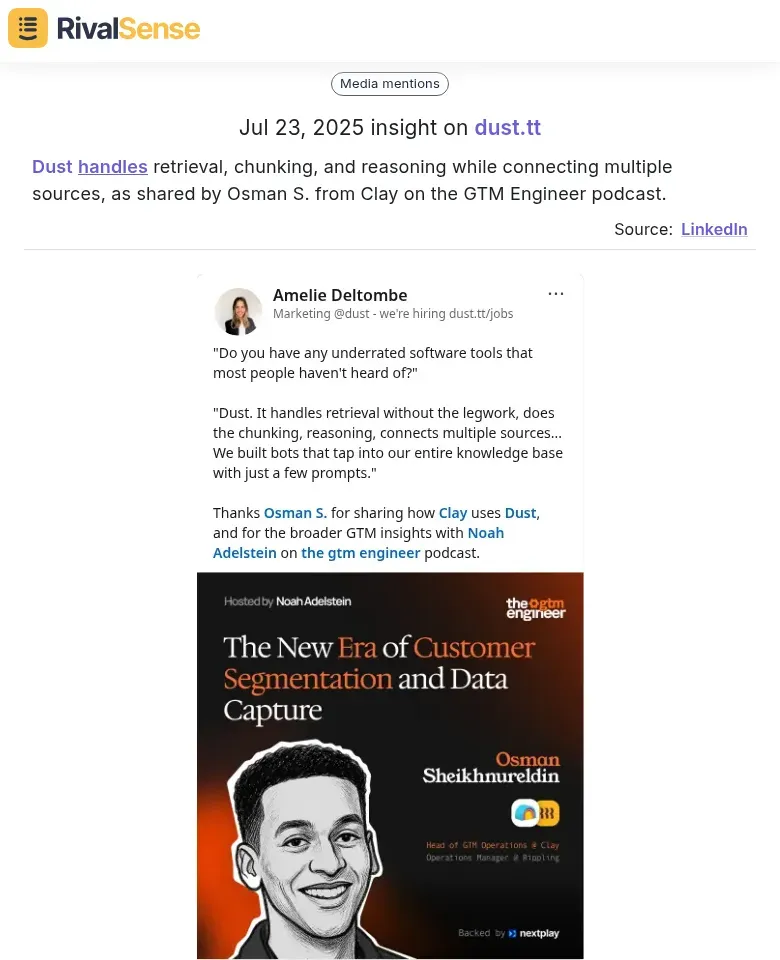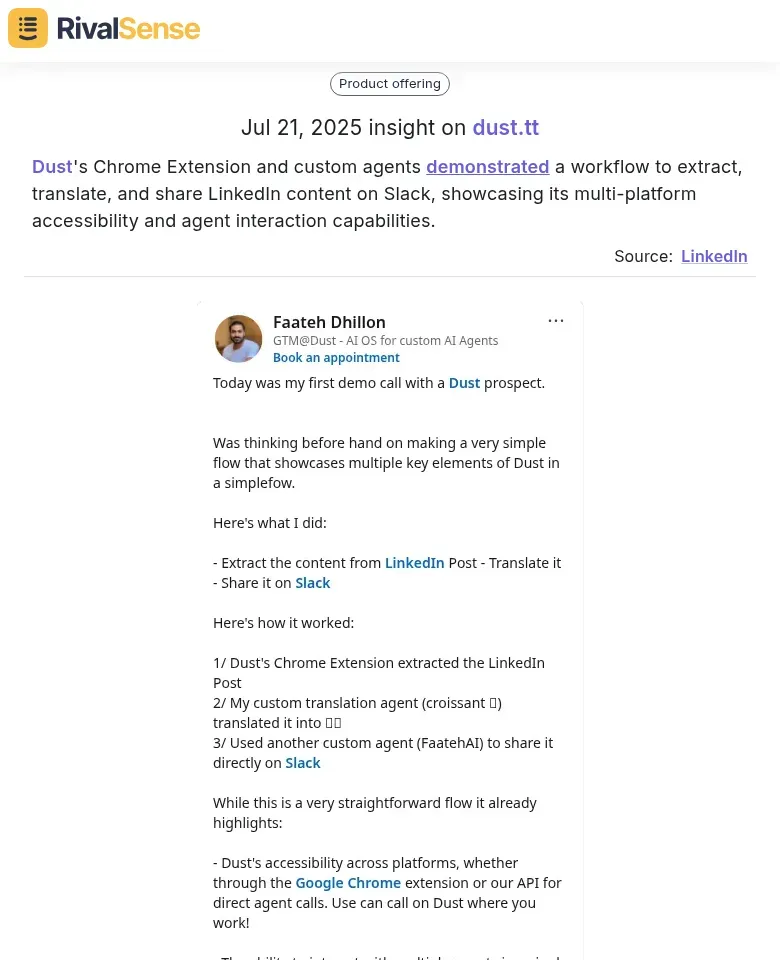Beginner’s Guide to Tracking AI Competitors Like Dust
In today's rapidly evolving tech landscape, tracking AI competitors like Dust is essential for maintaining a competitive edge. Understanding their strategies, product innovations, and market positioning provides invaluable insights that directly inform your strategic decisions. For founders and CEOs of B2B companies, this intelligence can mean the difference between leading the market and playing catch-up. Dust's approach to customizable AI agents demonstrates how integration flexibility becomes a key differentiator in crowded markets. This guide will walk you through practical steps to implement effective competitor tracking, from identifying key players to leveraging monitoring tools for continuous insights.
Learning from Industry Leaders: Podcast Insights
Podcasts offer unparalleled access to industry leaders' strategic thinking and future roadmaps. When Dust's CEO Stanislas Polu discussed AI agents' impact on work with LangChain's CEO Harrison Chase, it revealed Dust's vision for workplace transformation. Such conversations provide early signals about market direction and innovation priorities that can shape your product development. Here’s how to leverage these golden insights:

Why it matters: Tracking executive thought leadership helps anticipate industry shifts before they mainstream, allowing strategic alignment.
- Spot Emerging Trends: Focus on how leaders frame challenges—like Dust emphasizing AI-driven productivity boosts.
- Extract Tactical Wisdom: Note specific implementation examples mentioned during discussions.
- Practical Steps:
- Subscribe to 3-5 industry podcasts
- Assign team members to summarize key takeaways
- Host monthly "insight translation" workshops
✅ Action Checklist:
- [ ] Identify top podcasts in your niche
- [ ] Create shared repository for episode notes
- [ ] Map insights to your product roadmap quarterly
Technical Capabilities and Innovations
Understanding competitors' technical architectures reveals opportunities for differentiation. Dust's approach to retrieval, chunking, and reasoning—connecting multiple data sources—showcases how robust infrastructure enables advanced functionality. When Osman S. from Clay detailed this on the GTM Engineer podcast, it highlighted Dust's focus on seamless data synthesis.

Why it matters: Technical disclosures signal scalability strengths and potential partnership opportunities.
Optimize your analysis with these steps:
- Deconstruct Tech Stacks: Reverse-engineer competitors' capabilities from public materials
- Benchmark Performance: Compare processing speeds, error rates, and integration depth
- Identify Innovation Gaps: Note where their solutions struggle—these become your opportunities
| Capability | Dust's Approach | Your Action |
|---|---|---|
| Data Retrieval | Multi-source aggregation | Audit your data pipelines |
| Chunking | Context-aware segmentation | Test fragmentation efficiency |
| Reasoning | Layered interpretation models | Evaluate ML model sophistication |
Multi-Platform Accessibility and Workflow Integration
Modern AI solutions must operate across ecosystems to deliver real value. Dust's Chrome Extension demonstration—extracting LinkedIn content, translating it, and sharing to Slack—exemplifies how seamless cross-platform workflows become competitive advantages. Tracking such integrations reveals how competitors solve real user friction points.

Why it matters: Product demonstrations expose usability strengths that influence customer adoption decisions.
Actionable integration strategies:
- Map competitor workflow touchpoints (web/mobile/desktop)
- Time-to-value analysis: How quickly do they deliver results?
- Identify "glue tools" (like Slack/Teams connectors) that enhance stickiness
✅ Integration Audit Checklist:
- [ ] Document all supported platforms
- [ ] Test onboarding friction points
- [ ] Note automation capabilities
- [ ] Compare user customization depth
Strategic Takeaways for Your Business
Competitor intelligence transforms from data to strategy when systematically applied. Dust's model-agnostic platform demonstrates how flexibility addresses evolving market needs. To operationalize insights:
- Prioritize Monitoring Channels: Focus on high-signal sources like product changelogs and executive interviews
- Build Comparison Frameworks: Regularly score competitors across:
- Innovation velocity
- Implementation complexity
- Ecosystem integration
- Turn Insights into Action: Dedicate quarterly workshops to translate findings into product features
Conclusion and Next Steps
Tracking competitors like Dust reveals critical patterns—from technical architectures to workflow philosophies—that sharpen your strategic edge. Consistent monitoring helps anticipate market shifts while identifying whitespace opportunities. Remember: The goal isn't imitation, but informed innovation.
Immediate actions to launch your tracking:
- Identify your top 3 competitors
- Set up monitoring for their product updates and executive communications
- Schedule monthly competitive review sessions
🔍 Ready to streamline competitor intelligence?
Try RivalSense for free and get your first automated competitor report today. Track product launches, pricing changes, leadership insights, and tech innovations—all delivered in actionable weekly briefings.
📚 Read more
👉 Competitor Product Insights: A Strategic Tool for Boosting Analyst Relations
👉 Decoding Competitor Moves: Martian's New Code Platform
👉 Automated Competitive Analysis Tools: The Ultimate Guide for 2025
👉 How to Leverage Strategic Market Intelligence in Accounting
👉 How Oliver Bonas' Beauty Expansion Strategy Can Inspire Your Competitive Edge
